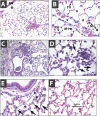An official American Thoracic Society workshop report: features and measurements of experimental acute lung injury in animals
- PMID: 21531958
- PMCID: PMC7328339
- DOI: 10.1165/rcmb.2009-0210ST
An official American Thoracic Society workshop report: features and measurements of experimental acute lung injury in animals
Abstract
Acute lung injury (ALI) is well defined in humans, but there is no agreement as to the main features of acute lung injury in animal models. A Committee was organized to determine the main features that characterize ALI in animal models and to identify the most relevant methods to assess these features. We used a Delphi approach in which a series of questionnaires were distributed to a panel of experts in experimental lung injury. The Committee concluded that the main features of experimental ALI include histological evidence of tissue injury, alteration of the alveolar capillary barrier, presence of an inflammatory response, and evidence of physiological dysfunction; they recommended that, to determine if ALI has occurred, at least three of these four main features of ALI should be present. The Committee also identified key "very relevant" and "somewhat relevant" measurements for each of the main features of ALI and recommended the use of least one "very relevant" measurement and preferably one or two additional separate measurements to determine if a main feature of ALI is present. Finally, the Committee emphasized that not all of the measurements listed can or should be performed in every study, and that measurements not included in the list are by no means "irrelevant." Our list of features and measurements of ALI is intended as a guide for investigators, and ultimately investigators should choose the particular measurements that best suit the experimental questions being addressed as well as take into consideration any unique aspects of the experimental design.
Figures



Comment in
-
Defining lung injury in animals.Am J Respir Cell Mol Biol. 2013 Feb;48(2):267. doi: 10.1165/rcmb.2011-0198le. Am J Respir Cell Mol Biol. 2013. PMID: 23378486 No abstract available.
-
Reply: defining lung injury in animals.Am J Respir Cell Mol Biol. 2013 Feb;48(2):267-8. doi: 10.1165/rcmb.2012-0074le. Am J Respir Cell Mol Biol. 2013. PMID: 23487848 Free PMC article. No abstract available.
Similar articles
-
Update on the Features and Measurements of Experimental Acute Lung Injury in Animals: An Official American Thoracic Society Workshop Report.Am J Respir Cell Mol Biol. 2022 Feb;66(2):e1-e14. doi: 10.1165/rcmb.2021-0531ST. Am J Respir Cell Mol Biol. 2022. PMID: 35103557 Free PMC article.
-
Defining lung injury in animals.Am J Respir Cell Mol Biol. 2013 Feb;48(2):267. doi: 10.1165/rcmb.2011-0198le. Am J Respir Cell Mol Biol. 2013. PMID: 23378486 No abstract available.
-
Early Identification of Acute Lung Injury in a Porcine Model of Hemorrhagic Shock.J Surg Res. 2020 Mar;247:453-460. doi: 10.1016/j.jss.2019.09.060. Epub 2019 Oct 24. J Surg Res. 2020. PMID: 31668606
-
Acute lung injury review.Intern Med. 2009;48(9):621-30. doi: 10.2169/internalmedicine.48.1741. Epub 2009 May 1. Intern Med. 2009. PMID: 19420806 Review.
-
Intestinal barrier damage, systemic inflammatory response syndrome, and acute lung injury: A troublesome trio for acute pancreatitis.Biomed Pharmacother. 2020 Dec;132:110770. doi: 10.1016/j.biopha.2020.110770. Epub 2020 Oct 2. Biomed Pharmacother. 2020. PMID: 33011613 Review.
Cited by
-
Recombinant thrombomodulin and recombinant antithrombin attenuate pulmonary endothelial glycocalyx degradation and neutrophil extracellular trap formation in ventilator-induced lung injury in the context of endotoxemia.Respir Res. 2024 Sep 3;25(1):330. doi: 10.1186/s12931-024-02958-0. Respir Res. 2024. PMID: 39227918 Free PMC article.
-
AICAR decreases acute lung injury by phosphorylating AMPK and upregulating heme oxygenase-1.Eur Respir J. 2021 Dec 23;58(6):2003694. doi: 10.1183/13993003.03694-2020. Print 2021 Dec. Eur Respir J. 2021. PMID: 34049949 Free PMC article.
-
Deficiency of Acute-Phase Serum Amyloid A Exacerbates Sepsis-Induced Mortality and Lung Injury in Mice.Int J Mol Sci. 2023 Dec 15;24(24):17501. doi: 10.3390/ijms242417501. Int J Mol Sci. 2023. PMID: 38139330 Free PMC article.
-
Hepatocyte growth factor-modified mesenchymal stem cells improve ischemia/reperfusion-induced acute lung injury in rats.Gene Ther. 2017 Jan;24(1):3-11. doi: 10.1038/gt.2016.64. Epub 2016 Aug 24. Gene Ther. 2017. PMID: 27556817
-
Nur77 attenuates endothelin-1 expression via downregulation of NF-κB and p38 MAPK in A549 cells and in an ARDS rat model.Am J Physiol Lung Cell Mol Physiol. 2016 Dec 1;311(6):L1023-L1035. doi: 10.1152/ajplung.00043.2016. Epub 2016 Oct 7. Am J Physiol Lung Cell Mol Physiol. 2016. PMID: 27765761 Free PMC article.
References
-
- Bernard GA, Artigas A, Brigham KL, Carlet J, Falke K, Hudson L, Lamy M, LeGall JR, Morris A, Spragg R. Report of the American-European consensus conference on acute respiratory distress syndrome: Definitions, mechanisms, relevant outcomes, and clinical trial coordination. Consensus Committee. J Crit Care 1994;9:72–81. - PubMed
-
- Davies B, Morris T. Physiological parameters in laboratory animals and humans. Pharm Res 1993;10:1093–1095. - PubMed
-
- Hamelmann E, Schwarze J, Takeda K, Oshiba A, Larsen GL, Irvin CG, Gelfand EW. Noninvasive measurement of airway responsiveness in allergic mice using barometric plethysmography. Am J Respir Crit Care Med 1997;156:766–775. - PubMed
Publication types
MeSH terms
Substances
Grants and funding
LinkOut - more resources
Full Text Sources
Other Literature Sources

